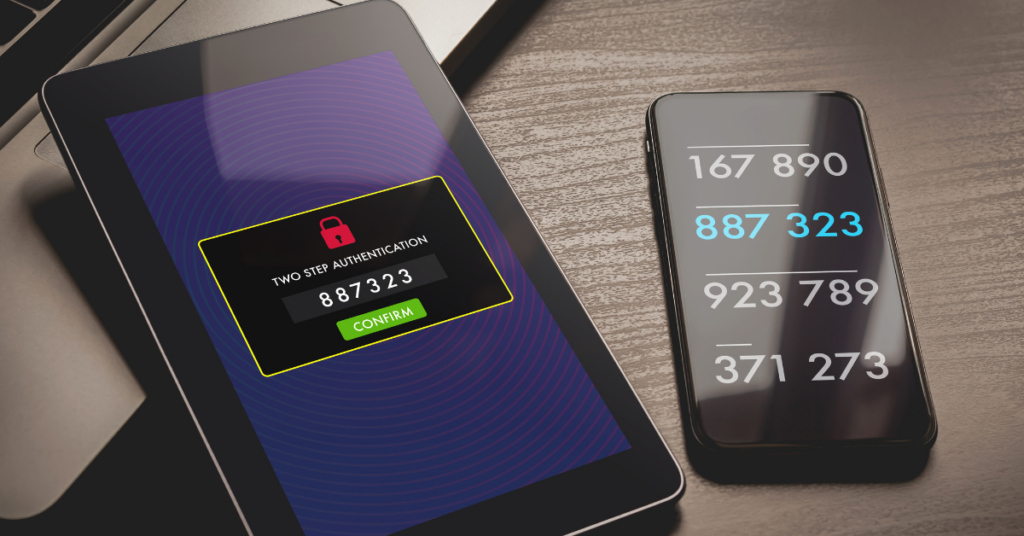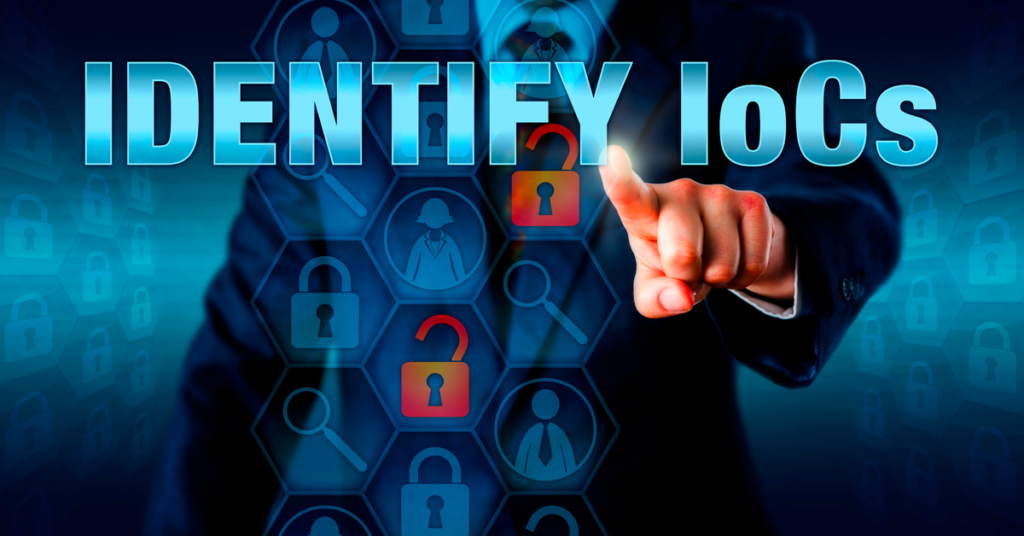SaaS Security Software: A Buyer’s Guide for MSPs
The growth of SaaS applications has been nothing short of spectacular. Once considered a niche offering, cloud-based SaaS apps are now a staple for almost every industry. According to Gartner, worldwide end-user spending on SaaS is projected to increase by 17.9% to a total of $197 billion in 2023.
While software-as-a-service (SaaS) is thriving, there is a growing concern for security among MSPs as well as their clients. The Annual SaaS Security Survey Report found that 55% of organizations experienced a security incident in the past two years, underscoring the need for robust SaaS security platforms.
What Is SaaS Security?
SaaS security refers to the measures and processes implemented to protect SaaS applications and associated data.
Cloud applications are a common gateway for cybercriminals to steal sensitive and confidential data. In fact, SaaS was the most targeted area for cyberattacks in 2022, per the Thales Global Cloud Security Study.
While traditional security tools such as perimeter defense successfully secure on-premises networks, guarding cloud assets requires specialized platforms that are optimized for cloud-hosted software.
| SaaS Security Solutions | Traditional Security Solutions | |
| Focus | Address the security needs of cloud-based SaaS applications and services | Secure on-premises systems and networks, including data centers, endpoint devices and software deployments |
| Architecture | Has a cloud-native distributed architecture deployed across multiple servers or nodes | Require dedicated hardware and software installations |
| Scalability | Can scale dynamically and accommodate changing workloads without major reconfiguration | Can be more challenging to scale, as they involve hardware purchases and manual configurations |
| Management and Updates | Ensure that the latest security measures are applied automatically | Require MSPs to manage and update the security solutions manually |
How to Select SaaS Security Solutions
Just as a masterful knight selects the perfect armor, you must select a SaaS security solution that suits your digital kingdom’s needs and defends against menacing cyber villains.
Here are five top factors to help you determine the best cloud SaaS security software.
1. Monitoring and Alerts
A security platform that combines monitoring and cybersecurity alerts helps to proactively detect, respond to and mitigate SaaS security issues.
SaaS monitoring involves the continuous observation and analysis of the following activities:
- User activity such as logins and file access from unauthorized locations or exceeding the limit of file downloads. Tracking these activities helps security teams detect any anomalies in user behavior.
- Access attempts of sensitive data such as financial records and legal documents. Keeping track of the locations, IP addresses and devices accessing confidential information helps identify when an unauthorized attempt is made.
- Changes in the configuration of application settings and permissions. Monitoring such activities detects when malicious actors attempt to move laterally across systems to expand their control and escalate privileges.
- Performance and health of SaaS applications. Identifying performance bottlenecks, downtime and resource issues helps prevent potential security risks, such as attacks during vulnerable periods or attempts to exploit system weaknesses.
As an industry-leading SaaS security monitoring system, SaaS Alerts sends a security alert via email, text message or dashboard notification when our platform detects an activity that matches your predefined rules. To help prioritize remediation efforts based on the severity of the security events, we rank events in three categories — Low, Medium and Critical.
Here are the most common security events SaaS Alerts recorded and categorized in 2022:
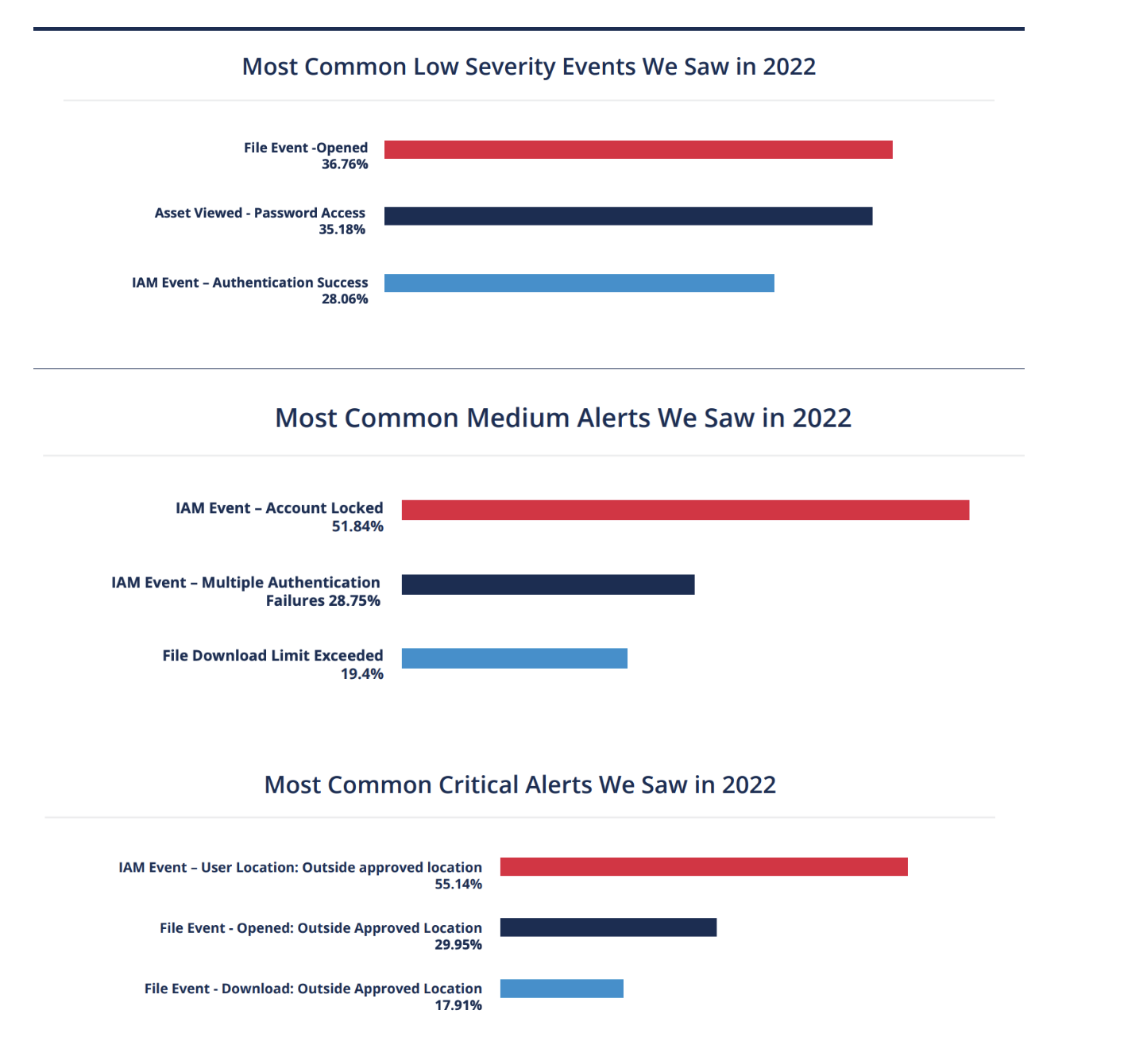
Download our 2023 SaaS Application Security Insights (SASI) Report to discover how MSPs can protect their customers from SaaS security concerns.
2. Automated Detection and Response
Automated detection and response work in tandem to continuously monitor the SaaS environment for suspicious activities and take immediate action when a threat is identified. The two are an integral part of the SaaS security checklist because they ensure:
- Speed and accuracy: Automated systems can swiftly and accurately analyze vast amounts of data.
- Rapid mitigation: Automated incident response triggers actions such as blocking compromised accounts and malicious IP addresses to prevent data breaches.
- 24/7 vigilance: The system operates around the clock, ensuring your SaaS environment is protected even when human monitoring might be limited.
- Human effort optimization: Automating routine tasks allows MSPs to reprioritize their activities and focus on more sophisticated attacks that require human expertise.
The Respond module offered by SaaS Alerts makes it easy for MSPs to automatically remediate detected threats by taking steps such as locking an account when a breach occurs and terminating unauthorized file-sharing activities.
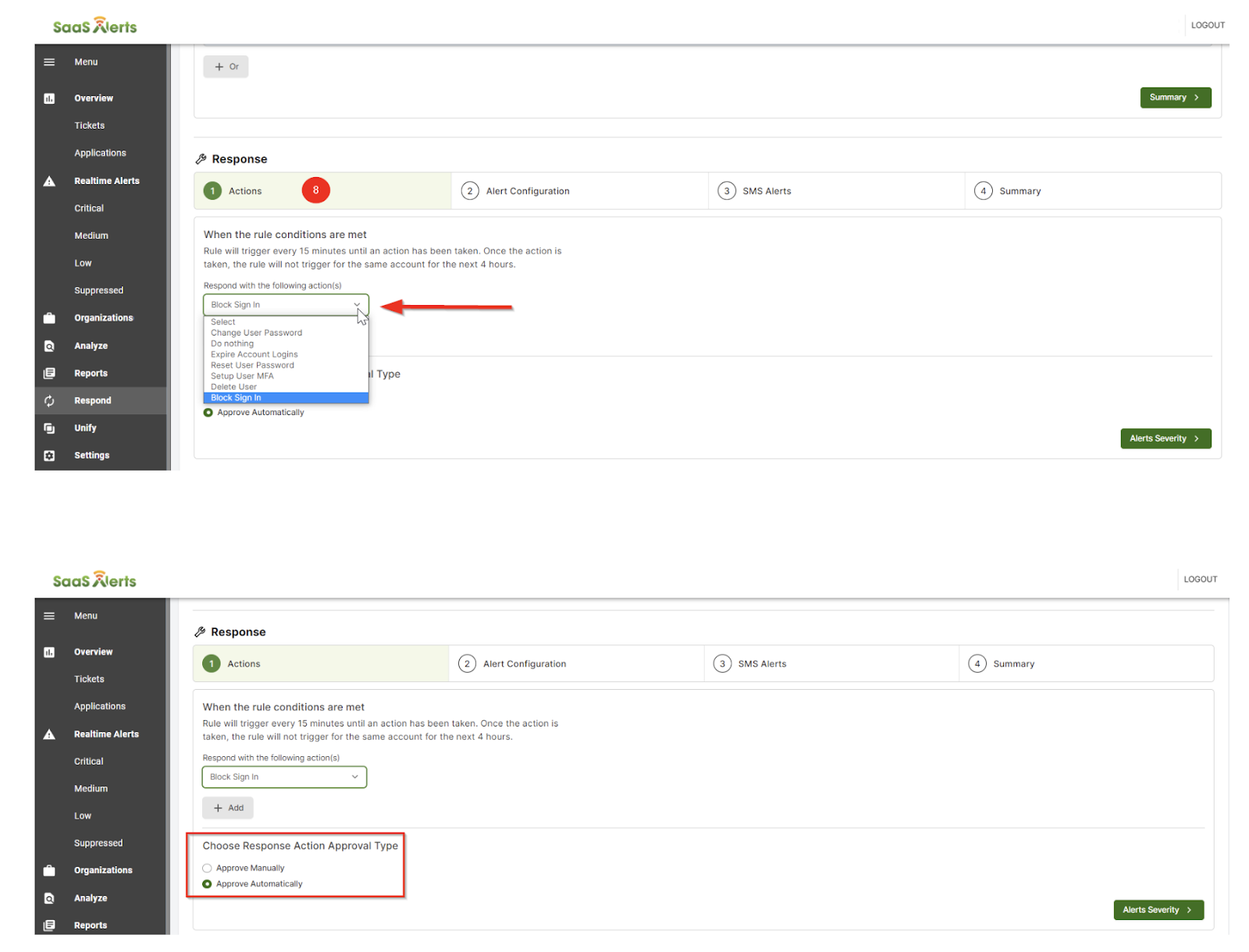
3. Integration Capabilities
MSPs rely on an array of software such as RMM tools, network monitoring tools, performance optimization software, collaboration tools, vulnerability scanners and more. To ensure these tools are not operating in silos and preventing a holistic security approach, the SaaS security solution should have robust integration capabilities.
SaaS Alerts offers seamless integration into the most commonly used MSP tools to:
- Eliminate the need for redundant processes
- Manage security seamlessly within established systems
- Provide a holistic security solution
With SaaS Alerts, MSPs do not need to monitor the dashboard constantly. The data that requires attention and investigation is automatically funneled into their existing systems. This automation contributes to faster response times, improved client service and a more effective approach to securing multiple client environments.
4. Reporting Capabilities
Providing comprehensive reports of events is a cornerstone of effective cybersecurity management that enhances threat awareness and enables proactive decision-making.
Here’s how reporting capabilities of SaaS security software can help MSPs:
- Informed decision-making: Reports offer the data needed to make informed decisions about security incidents and avoid knee-jerk reactions.
- Prioritization: Reporting helps MSPs identify high-priority threats that require immediate attention, to ensure appropriate allocation of resources.
- Auditing: Reports serve as audit trails that show the organization’s security measures, incident response and overall security posture. They serve as evidence of due diligence during audits.
- Performance analysis: Reports allow MSPs to assess the effectiveness of their security strategies, identify areas for improvement and refine their approach against threats.
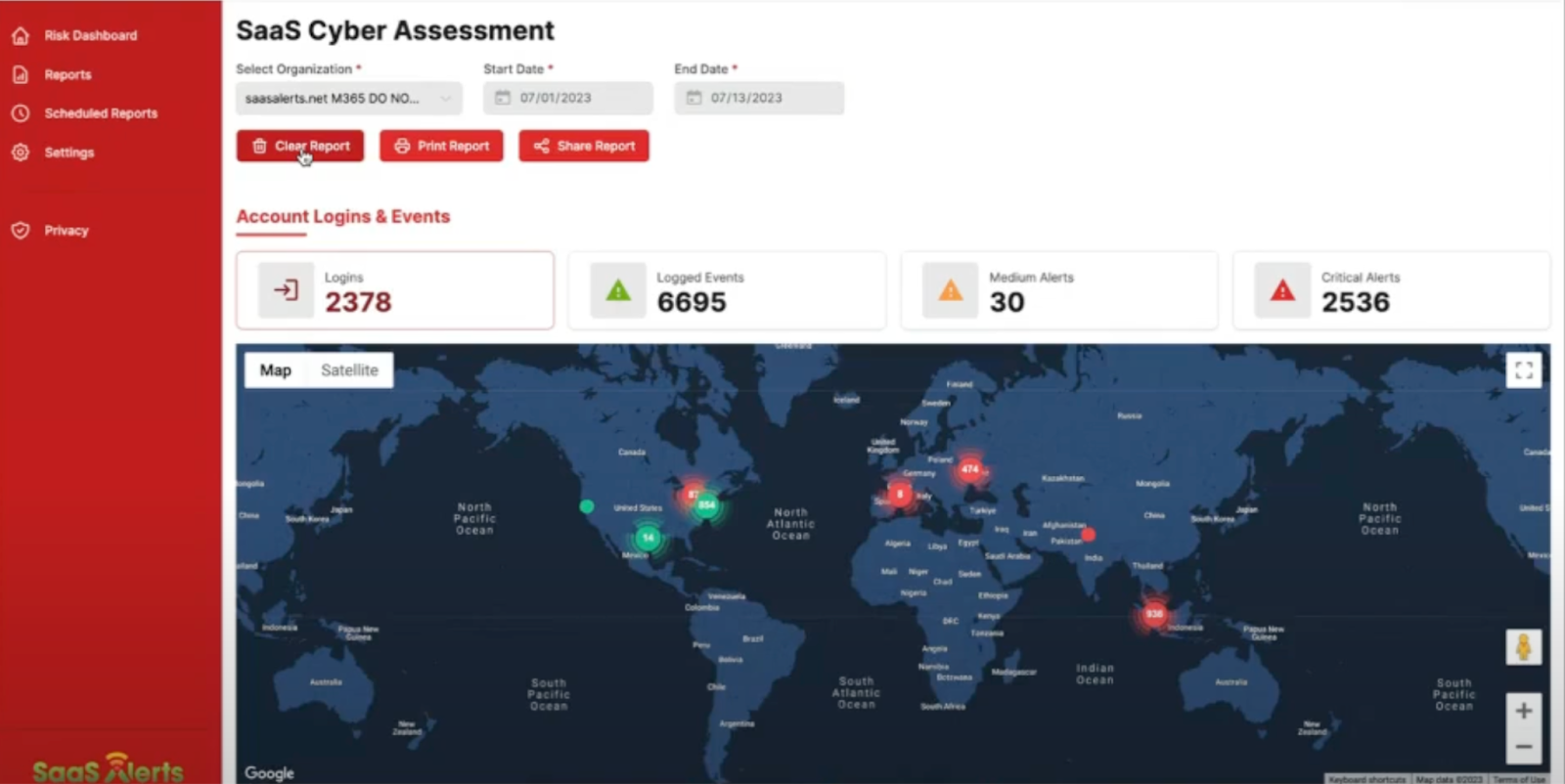
Looking to dive deeper into your client’s application layer and user behavior? Our SaaS Cyber Assessment helps MSPs analyze and report on the current security environment of customers.
5. SaaS Compliance and Certifications
Following industry compliance standards and certifications adds to the credibility of the security provider. Regulatory bodies have issued SaaS security best practices to ensure that organizations and MSPs maintain a secure digital environment.
MSPs should evaluate if the provider follows SaaS security standards to:
- Avoid legal consequences: Non-compliance with industry regulations can lead to legal consequences, fines and damages to the MSP’s reputation.
- Protect sensitive customer data: To combat SaaS security challenges, your provider should comply with relevant data protection regulations such as GDPR.
- Comply with data residency rules: Data-residency certifications indicate compliance with regulations that require data to be stored within specific geographic boundaries.
- Meet industry-specific requirements: Clients in specific industries may have stringent security compliance (e.g., HIPAA for healthcare). Partnering with a compliant provider helps MSPs serve clients across diverse industries.
Read more about where SaaS Alerts stores its data.
Improve Your Cybersecurity with SaaS Alerts
No matter the company’s size, all organizations need to keep their software apps secure.
Helping MSPs protect data and create monthly recurring revenue, SaaS Alerts ticks all the boxes of a purpose-built SaaS security platform:
✅ Continuous threat detection
✅ Automated remediation
✅ Comprehensive reporting of security alerts
✅ Seamless integration with your tech stack
✅ Compliance with industry standards
Request a free trial for a front-row seat of SaaS Alerts in action.

